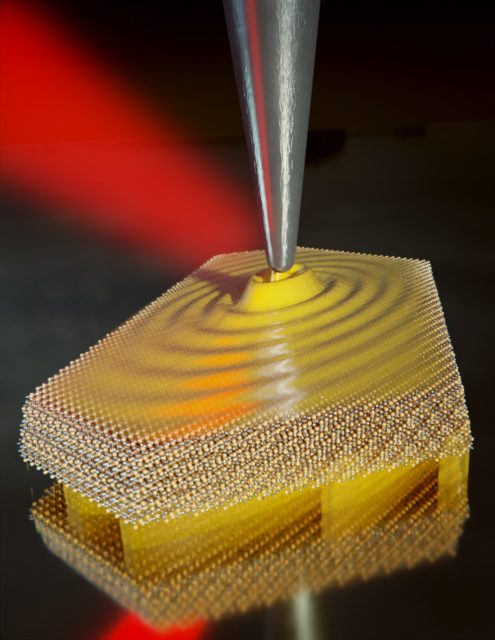First real-space images of THz plasmon polaritons
Polaritons attract wide attention due to their ability to confine and guide light at the nanometre scale. These capacities are key for the development of ultrasmall resonators and waveguides that can be used for sensing, heat transfer and optical circuitry applications. But, what are polaritons in the first place?
If, for the sake of the argument, we consider an electron missing, a hole, a proton lookalike, an exciton can be described as an electron-hole pair in a crystal that is bound in a manner analogous to the electron and proton in a hydrogen atom. Excitons are induced by an electromagnetic wave, a photon. In some cases the frequencies of vibration of the incoming photon and the resulting exciton are very similar, and they resonate. When they have a strong resonance interaction with each other a quasi-particle results from the admixture of states of the photon and the exciton, the polariton. Thus, generally speaking, polaritons are quasiparticles resulting from the strong coupling of photons with a dipole-carrying excitation. Hence, we have phonon polaritons that are the result of the coupling of an infrared photon with an optic phonon, or plasmon polaritons, that result from the coupling of surface plasmons with light.
The control and manipulation of polaritons can be largely expanded with naturally anisotropic materials. Importantly, when a polaritonic material exhibits optical anisotropy along its surface, polaritons can propagate with ultrashort and direction-dependent wavelengths. Thin layers of in-plane anisotropic materials can support these ultraconfined polaritons, with wavelengths up to 100 times shorter than the corresponding photon wavelength, allowing for manipulation of light on a much smaller scale than previously possible with conventional photonic devices. However, the real-space observation of ultraconfined in-plane anisotropic plasmon polaritons —which exist in much broader spectral ranges than phonon polaritons—has been elusive.
On the other hand, terahertz (THz) radiation is all around us. For example, this page emits blackbody radiation mainly in the THz region (defined here from 0.3 THz to 30 THz). In condensed matter physics and in general, THz radiation is an efficient tool to investigate a multitude of low-energy excitations existing in the THz region. Important examples are resonances of phonons and plasmons.

Now, a team of researchers has used 1 scattering-type scanning near-field optical microscopy (s-SNOM) to image ultraconfined in-plane anisotropic THz plasmon polaritons on monoclinic Ag2Te (hessite) platelets. Ag2Te is a narrow-bandgap semiconductor, where the effective masses of the charge carriers exhibit strong anisotropy. The team obtained the first real-space images of THz plasmon polaritons, whose wavelengths are up to 65 times reduced compared to the photon wavelength, depending on the propagation direction.
The hybridization of the plasmon polaritons with their mirror image—by placing the platelets above a gold layer—increases the direction-dependent relative polariton propagation length and the directional polariton confinement.
This work shows high-symmetry (elliptical) polaritons on low-symmetry (monoclinic) crystals and demonstrates that terahertz plasmon polaritons can be used for local measurements of anisotropic charge carrier masses and damping.
References
- S. Chen, P. L. Leng, A. Konečná, E. Modin, M. Gutierrez-Amigo, E. Vicentini, B. Martín-García, M. Barra-Burillo, I. Niehues, C. Maciel Escudero, X. Y. Xie, L. E. Hueso, E. Artacho, J. Aizpurua, I. Errea, M. G. Vergniory, A. Chuvilin, F. X. Xiu, R. Hillenbrand (2023) Real-space observation of ultra-confined in-plane anisotropic acoustic THz plasmon polaritons Nature Materials doi: 10.1038/s41563-023-01547-8 ↩